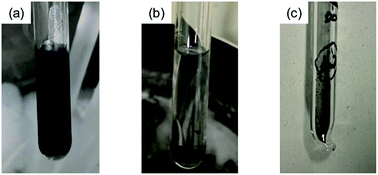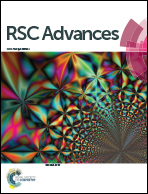A new protocol for the preparation of superconducting KBi2
Abstract
A superconducting KBi2 sample was successfully prepared using a liquid ammonia (NH3) technique. The temperature dependence of the magnetic susceptibility (M/H) showed a superconducting transition temperature (Tc) as high as 3.6 K. In addition, the shielding fraction at 2.0 K was evaluated to be 87%, i.e., a bulk superconductor was realized using the above method. The Tc value was the same as that reported for the KBi2 sample prepared using a high-temperature annealing method. An X-ray diffraction pattern measured based on the synchrotron X-ray radiation was analyzed using the Rietveld method, with a lattice constant, a, of 9.5010(1) Å under the space group of Fd![[3 with combining macron]](https://www.rsc.org/images/entities/char_0033_0304.gif) m (face-centered cubic, no. 227). The lattice constant and space group found for the KBi2 sample using a liquid NH3 technique were the same as those reported for KBi2 through a high-temperature annealing method. Thus, the superconducting behavior and crystal structure of the KBi2 sample obtained in this study are almost the same as those for the KBi2 sample reported previously. Strictly speaking, the magnetic behavior of the superconductivity was different from that of a KBi2 sample reported previously, i.e., the KBi2 sample prepared using a liquid NH3 technique was a type-II like superconductor, contrary to that prepared using a high-temperature annealing method, the reason for which is fully discussed. These results indicate that the liquid NH3 technique is effective and simple for the preparation of a superconducting KBi2. In addition, the topological nature of the superconductivity for KBi2 was not confirmed.
m (face-centered cubic, no. 227). The lattice constant and space group found for the KBi2 sample using a liquid NH3 technique were the same as those reported for KBi2 through a high-temperature annealing method. Thus, the superconducting behavior and crystal structure of the KBi2 sample obtained in this study are almost the same as those for the KBi2 sample reported previously. Strictly speaking, the magnetic behavior of the superconductivity was different from that of a KBi2 sample reported previously, i.e., the KBi2 sample prepared using a liquid NH3 technique was a type-II like superconductor, contrary to that prepared using a high-temperature annealing method, the reason for which is fully discussed. These results indicate that the liquid NH3 technique is effective and simple for the preparation of a superconducting KBi2. In addition, the topological nature of the superconductivity for KBi2 was not confirmed.



 Please wait while we load your content...
Please wait while we load your content...